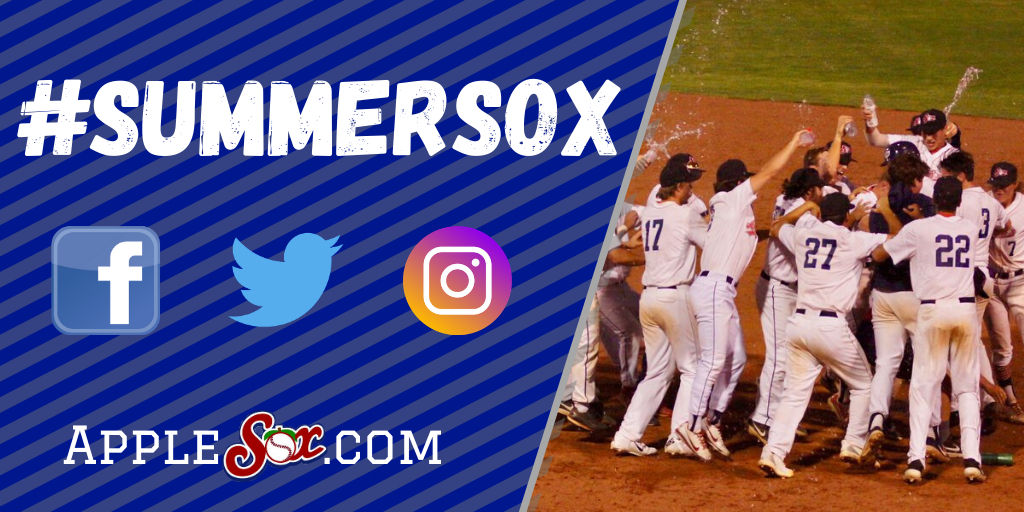Sanderson Returns to Familiar Place to Coach AppleSox
/Change is as much a part of the West Coast League’s very fabric as cowhide is to baseballs. Every season, teams expect a large majority of the previous season’s players to not return.
The same goes for each team’s coaching staff. Seven different teams have changed head coaches for the 2020 season, so far. The AppleSox opened up the offseason coaching changes when they named Ian Sanderson their fifth head coach in team history on Sept. 19.
Last year, four teams began the season with a different head coach from the previous season (Bend, Kelowna, Ridgefield, Victoria). One of them, Kelowna, brought in a new head coach a year after making the playoffs. Sound familiar?
Don’t forget, teams at the major-league level have brought in new managers after making the playoffs. The New York Yankees came a win away from advancing to the World Series in 2017 with Joe Girardi, then hired Aaron Boone to replace him after the season.
After qualifying for the WCL playoffs for the first time in six seasons last summer, the AppleSox are looking to take the next step in 2020 and they believe Sanderson is the man to bring home another championship. Part of their reasoning for hiring Sanderson was due to his familiarity with the Valley.
“I used to go to Wenatchee AppleSox games when I was younger,” Sanderson said. “I have family in Wenatchee, so we spent summers there. Wenatchee is a special place and a nostalgic flashback for me from my childhood. I remember the stands being just jam-packed with excitement and buzz. I remember the nice weather and the sun setting over the hills in the fourth inning or so.”
Sanderson comes to the AppleSox after spending last season with the Victoria HarbourCats, who defeated the AppleSox in three games before falling to the Corvallis Knights in the West Coast League Championship. The HarbourCats finished tops of second in the WCL in innings, strikeouts, opponent batting average and ERA.
Sanderson currently works full-time as the associate head coach and pitching coach for Lower Columbia College, the 2017-19 NWAC Champions. It’s a program not only full of success, but also one with AppleSox blood. Lower Columbia College’s head coach, Eric Lane, employs Sanderson as his associate head coach and pitching coach. Lane played for the AppleSox in 2010 and then later served as an assistant coach in 2013. He played a part in helping his assistant become a member of the AppleSox family.
“He just talked about how fun it was as a player and just loves Wenatchee,” Sanderson said. “He’s already planning a trip to a game with a few ex-AppleSox that he played with and we’ll have to make it a fun weekend for them.”
Success is in Sanderson’s DNA. He saw firsthand what success the AppleSox achieved previously and is eager to return the team to that dynastic level that it previously held. The blend of that challenge and memories of summers from yesteryear brought Sanderson to the AppleSox.
“I think it’s about getting the right guys in and connecting with the community,” Sanderson said. “I want to build the fanbase to get excited again and build a winning attitude. We aren’t going to be an overly heavy roster where we have a new roster every day. A lot of guys are going to play two out of three days or three out of four days.”
As for his coaching style, Sanderson is focused on dominating with pitching. Naturally, with a pitching coach background, he wants to dictate games based on what his players can do on the mound. Sanderson wants to bring in “as many arms as possible,” because he believes that with the innings and pitch-count limits that schools place on pitchers, having as many options as possible on the mound is the best way to earn back-to-back playoff berths.
However, that doesn’t mean Sanderson isn’t creative about what can be done offensively. He told fans at February’s Hot Stove Party that he wants to “create chaos” every time AppleSox hitters step into the batter box.
“We’re going to let guys play a bit,” Sanderson said. “We’re not going to be sacrifice bunting a lot. We’re going to let guys hit and steal a lot of bases. I really liked that style that we played with the Victoria HarbourCats last summer while learning from Todd Haney: letting them learn to fail at stealing bases and try not to take the bat away with guys too much. Last year, the staff that we had recorded the fewest walks and we were No. 2 in ERA.”
AppleSox management conducted the search in early September and was pleased to find a quality candidate so early on in interviews.
“Ian was one of the first people who reached out to us,” general manager Ken Osborne said. “We obviously were familiar with his work with the HarbourCats, but were thrilled with his ability to communicate as well as his baseball philosophy. The fact that he has connections to the area makes it even better.”
The AppleSox and Sanderson both know that ultimately, winning is the goal in 2020. However, the biggest challenge confronting the AppleSox from reaching the peak of this climb is keeping as many players as possible for the bulk of the season or replacing them adequately. From July 29 to Aug. 8, 2019 (an 11-day span), a combined 15 AppleSox players who recorded at least 75 at-bats or appeared in at least 10 games on the mound were shut down for the rest of the season. The majority had been told by their head coaches that late-July to early-August would be the end of the summer ball season.
The central problem was that the WCL regular season didn’t end until Aug. 11 and the playoffs ended just under a week later. Many colleges were allowed to begin practicing once the calendar flipped to August and understandably chose to bring their players back from their summer-ball commitments.
When the AppleSox traveled to Corvallis for the final three games of the 2019 regular season, they brought 17 players with them and signed three pitchers to one-day contracts so that the best pitchers remaining could be rested for the postseason.
Remarkably, the Knights did not face a similar issue as the AppleSox. While AppleSox players hardly knew each other with the bulk of the roster consisting of late-season replacement players, the Knights hardly lost anyone significant. The eventual four-time defending West Coast League Champions and 2019 Perfect Game Team of the Year ended the regular season with 30 players on their roster, nearly double the number of active AppleSox players that same weekend. The Knights only lost five hitters from the entire 2019 season, four of whom recorded 15-or-fewer at-bats.
Sanderson, who faced the AppleSox’ skeleton crew in the postseason, believes that he is prepared to not make the same mistakes of a different regime from a year ago.
“Corvallis has found a way,” Sanderson said, “to find a majority of guys on that quarterly system and that’s what we’ve got to do. It was frustrating when we (Victoria) faced them in the championship round. The team that faced them wasn’t the team that got us to the playoffs. It’s not a knock on the guys who stayed, but it was just a different team. I think if we can control the roster and keep everybody around, I think it’s a much different league and the ‘top-heaviness’ goes away.”
Sanderson anticipates turnover on his 2020 roster. Too assume otherwise would be foolish, but his goal is to limit as much turnover as possible. That starts with communicating with players and their coaches better from the get-go, focusing on players who will be with the AppleSox for the majority of the season and having capable and planned replacements for those who don’t last the full summer.
Division-I players may excite fans most, but it’s also critical to supplement the rest of a summer-ball roster with Division-II and junior-college players. Often times, junior-college players are looking to advance to the Division-I level and hope to put together a strong summer to convince college coaches that they are worth a spot on the top tier of college student-athletes. Sanderson, as a junior-college coach, knows that having control of these players in addition to their hunger are excellent reasons to make them members of the AppleSox this summer.
“We’re going to get as many of the best junior college guys that we can,” Sanderson said, “because those are the guys that are going to be the supplemental guys that fill in early and fill in later because I know what their schedules are. It’s going to be a mix of pop-in junior college players.”
The AppleSox were part of league’s elite at one point, winning five of the first eight WCL Championships. However, the league has also expanded since its inception in 2005. Seven teams battled in the division-less inaugural season with only two teams granted a postseason berth. In 2020, 12 teams in two divisions compete for four postseason berths, with only two teams from each division advancing to the playoffs.
The times have changed and now, so too must the AppleSox. With Sanderson and his forward-thinking mind at the helm, the AppleSox look to return to their previous glory with a strong start to a new era in 2020.










